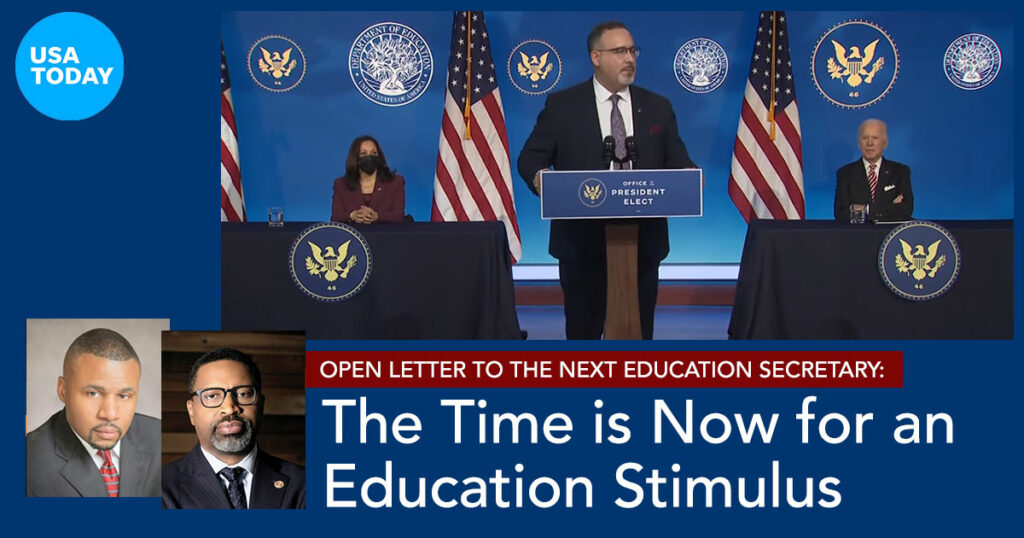Blog, News
Soon-to-be Secretary Miguel Cardona, the Time is Now for an Education Stimulus

Originally published in USA Today.
Congratulations on your nomination to be U.S. education secretary, Miguel Cardona. You are poised to take this position at a critical point in American history. As you know well, for generations we have lived through a system of separate and unequal education. COVID-19 has greatly exacerbated the learning loss disparities experienced by children of color. Now, with Congress failing to deliver to schools, educators, students, and parents the much-needed learning and PPE resources and states cutting their 2021 budgets, things are primed to get a lot worse.
When one couples the historic impact of structural racism on education with the challenges brought on by COVID-19, it is clear we are in a maze without a clear exit. But in times of uncertainty, the past can be a guiding light. One important lesson from the past: the positive impact of targeted economic stimulus packages.
Importance of stimulus packages
We know stimulus packages can make a difference. For example, according to the Department of Education, President Barack Obama’s American Recovery and Reinvestment Act “helped save or create an estimated 325,000 education jobs.” The stimulus needed now must go well beyond protecting teachers’ jobs, which are undoubtedly important, and extend to transforming learning and investing in families and community-based institutions. The bottom line is we cannot facilitate change and remedy years of divestment without an infusion of stimulus resources.
A stimulus moves us away from the scarce resources frame that too often dominates when confronting the need to invest in children. The bipartisan Emergency Economic Stabilization Act of 2008, which created the Troubled Assets Relief Program, a $700 billion fund to purchase toxic assets from banks, didn’t force banks or their CEOs to compete for needed resources to stabilize their operations. Instead, it provided them with well-calculated, targeted resources needed to do the job. Likewise, we are at a moment when the public education system, its students and educators are in dire need of resources to stabilize operations and eliminate the toxicity of racial disparities.
A targeted, multi-year $1-2 trillion Education Stabilization Program is a vital part of a larger Racial Equity Stimulus Package proposed by one of us, John Jackson, and other civil rights leaders. This education-focused stimulus would allow for the critical racial equity investments needed from birth and throughout the public preK-12 education system. It would serve as a stabilization fund for states whose education budgets are challenged by COVID-19-caused revenue shortfalls, while also requiring a maintenance of effort by states. It would also include investments to enable the expansion of community schools, address student mental health and socio-emotional needs, support states moving toward tuition-free community college, and make significant investments in Historically Black Colleges and Universities and other institutions that serve minorities and lead the nation in graduating students of color.
Stimulus resources are especially needed to address the significant learning loss caused by the pandemic, felt most deeply in communities of color. These targeted funds can contribute to making gains on eliminating racial disparities in education by liberating learning, upending the constraining structures and paradigms in the educational system which have led to learning disparities identifiable by race and ethnicity.
Inequality in education
Black students and other students of color have long faced a host of challenges where education is concerned — disproportionately under-resourced schools, school closures, criminalization in schools, a lack of teachers who look like them and curricula too often not culturally relevant to them. These biased policies and practices undeniably continue to limit education outcomes for Black and brown students and those from tribal communities. While most students have access to free public education, they remain shackled in achieving their learning potential. As such, it is impossible to address the systemic learning gaps without addressing the racially disparate learning constraints within the education system or, said another way, without liberating their learning.
In this moment of far-reaching change, we must pause to examine whether we are committed to investing in the future. That is the question we must pose to elected officials and those on whom the hopes of children and families rest.
If the twin pandemics of COVID-19 and structural racism experienced in 2020 have shown us anything, it is that there must be a radical shift in how we interact with those around us, and that should force us to rethink how we invest in and educate all students. It has exposed not only past education inequities but the danger of prolonged future disinvestment. While leadership by Congress and the president are needed to move the Racial Equity Stimulus package, your leadership is needed, Secretary Cardona, to target education investments to ensure that we liberate learning for all students and flatten the curve of structural racism so damaging to student learning in America.
John H. Jackson (@DrJohnHJackson) is president and CEO of the Schott Foundation for Public Education. Derrick Johnson (@DerrickNAACP) is the president of the NAACP.




